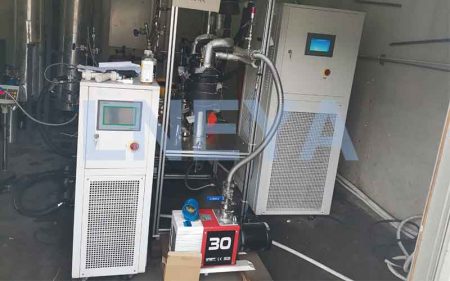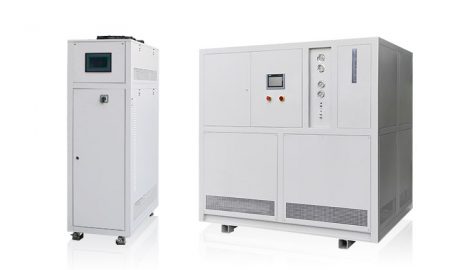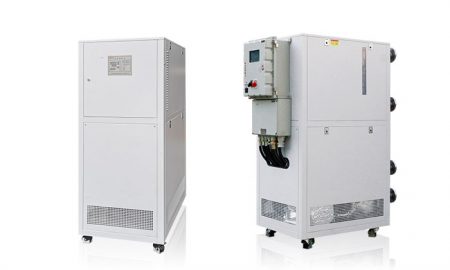Emulsifier Heating Process
Contacte-nos hoje para obter a solução perfeita de controlo da temperatura
In fluid mixing industrial production, most powder-liquid, solid-liquid, and liquid-liquid mixing require multiple processes of mechanical equipment to meet the required standards of the product. These processing steps often include: heating, dissolving, dispersing, stirring, homogenizing, emulsifying, sterilization, cooling, etc. Except for some cold-processed products, most products require a heating process during the mixing process. The heating process often requires the product to be fine, uniform, well dispersed, stable, etc. The heated materials of thermal processing products can be better sheared, homogenized and emulsified, allowing the product quality to reach a better state.

What are the heating methods of emulsifier?
1. Electric heating method
Among the emulsifier heating methods, electric heating is a common heating method. The electric heating method usually uses an electric heating rod installed in the emulsification tank to heat the medium in the interlayer of the emulsification tank: water or thermal oil. After the medium is heated, it transfers heat to the materials in the emulsification tank. The electric heating emulsifier has a fast heat transfer speed and uses a thermocouple to measure the temperature and connect it to a temperature controller to measure and control the temperature. The temperature control is adjustable and convenient; the temperature measurement is accurate. This heating method is convenient, hygienic, economical, safe and has a long heat preservation time.
2. Steam heating method
In some large-scale emulsifier equipment, or in situations where the process has temperature or other requirements, steam heating is often used to heat the materials. This heating method usually requires the customer to have a steam source, such as an industrial boiler. If there is no steam source, additional steam generator equipment is required to generate steam in advance through electrical heating for reuse. This heating method has fast heating speed, easy use and cooling, and can also be used for steam sterilization process. However, since this heating method creates pressure on the emulsification pot of the high-shear vacuum homogenizing emulsifier, it is often necessary to heat the pot with steam into the pressure vessel through an enterprise with a pressure vessel license to ensure production safety. Therefore, this heating method is relatively expensive.
In the production process of some products, standard electric heating and steam heating cannot meet the temperature requirements. External heating equipment can also be optional, such as external mold temperature controllers, chillers and other auxiliary equipment. To sum up, generally speaking, electric heating emulsifiers are more economical and affordable, and the heating effect and other aspects are guaranteed. From the perspective of cost, electric heating is more practical and therefore has a wider range of uses. Steam heating emulsifier is suitable for situations with large-scale output or special process requirements. In the production of products in some industries, especially the pharmaceutical industry that requires steam sterilization, steam heating is also commonly used.
Correio eletrónico: info@lneya.com ID WeChat: +8615251628237 WhatsApp: +86 17851209193

Sistemas de arrefecimento e aquecimento (série SUNDI)
Gama de controlo de temperatura: -120°C a +350°C
Application: Various Reactors (Microchannels, Glass, Jacketed Reactors, etc.), Distillation or Extraction System, Laboratory, University, Research Institute, Aerospace, Automotive Industry, Semiconductor and Electrical Test, Chemical, Pharmaceutical, Petrochemical, Biochemical, Medical, Hospital, R&D Workshop, Aerospace, Biological and Other Industries.
| Faixa de temperatura | Série -10 ~ +150°C | Série -25 ~ +200°C | Série -25 ~ +300°C | Série -45 ~ +250°C | Série -45 ~ +300°C | Série -60 ~ +250°C | Série -60 ~ +300°C | Série -70 ~ +250°C | Série -80 ~ +250°C | Série -90 ~ +250°C | Série -100 ~ +100°C | ||
| Capacidade de arrefecimento | 1,5 ~ 15kW | 1 ~ 200kW | 1 ~ 200kW | 0,45 ~ 200kW | 0,9 ~ 25kW | 0,25 ~ 60kW | 0,75 ~ 25kW | 0,4 ~ 15kW | 0,3 ~ 80kW | 0,2 ~ 80kW | 0,45 ~ 80kW | ||
| Nota: Qualquer faixa de temperatura de -150 ℃ ~ +350 ℃ e qualquer capacidade de resfriamento pode ser personalizada | |||||||||||||

Sistemas de arrefecimento e aquecimento (série WTD)
(Reactores de canal micro / tubo especializados)
Gama de controlo de temperatura: -70°C a +300°C
Design especializado para micro canal (pequena capacidade de retenção de líquido, forte capacidade de troca de calor, sistema de circulação de alta queda de pressão)
| Faixa de temperatura | -70°C ~ +300°C | -45°C ~ +250°C | -70°C ~ +200°C | ||||||
| Capacidade de arrefecimento | 1,1 ~ 7,5kW | 1,5 ~ 5,5kW | 11 ~ 50kW | ||||||
| Nota: Qualquer faixa de temperatura de -150 ℃ ~ +350 ℃ e qualquer capacidade de resfriamento pode ser personalizada | |||||||||

Circuladores de arrefecimento e aquecimento
Gama de controlo de temperatura: -45°C a +250°C
Application: Various Reactors (Microchannels, Glass, Jacketed Reactors, etc.), Distillation or Extraction System, Laboratory, University, Research Institute, Aerospace, Chemical, Pharmaceutical, Petrochemical, Biochemical, Medical, Hospital, R&D Workshop, Aerospace, Biological and Other Industries.
| Faixa de temperatura | Série -25°C ~ +200°C | Série -45°C ~ +250°C | |||||||
| Capacidade de arrefecimento | 1 ~ 15kW | 0,25 ~ 15kW | |||||||
| Nota: Qualquer faixa de temperatura de -150 ℃ ~ +350 ℃ e qualquer capacidade de resfriamento pode ser personalizada | |||||||||

Circuladores de aquecimento
Gama de controlo de temperatura: +50°C a +300°C
Nota: A série UC pode controlar a temperatura do meio de transferência de calor. A série UST pode não só controlar a temperatura do meio de transferência de calor, mas também controlar a temperatura do material de reação.
| Faixa de temperatura | +50°C ~ +170°C (série UC) | +50°C ~ +300°C (série UC) | +50°C ~ +300°C (série UST) | ||||||
| Capacidade de aquecimento | 5,5 ~ 15kW | 3,5 ~ 130kW | 3,5 ~ 95kW | ||||||
| Nota: Qualquer faixa de temperatura de -150 ℃ ~ +350 ℃ e qualquer capacidade de resfriamento pode ser personalizada | |||||||||
 LNEYA
LNEYA
 简体中文
简体中文


















































































